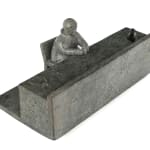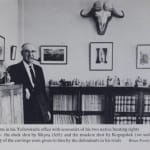UNIDENTIFIED ARTIST, KUGLUKTUK (COPPERMINE)
unsigned.
Further images
Judge John Howard Sissons is best known as the first judge of the territorial court of the Northwest Territories, appointed in 1955 and serving until his retirement in 1966. Throughout his tenure, Sissons played a pivotal role in reshaping the Canadian legal system to accommodate the unique cultural and social circumstances of the Indigenous peoples in the North. He often conducted court in remote communities, and his rulings reflected a deep respect for Indigenous traditions and customs.
One of Justice Sissons’s more famous cases was "The Duck Case," where his ruling in favour of Michel Sikyea ignited a major debate about treaty rights and Canadian law.
In the early 1960s, Michel Sikyea was charged with hunting a duck out of season by the Royal Canadian Mounted Police in. He was accused of violating the Migratory Birds Convention Act, which prohibited the hunting of migratory birds during certain times of the year. The case became significant because Sikyea argued that his right to hunt for food was protected by Treaty 11, which was signed in 1921 between the Canadian government and various Indigenous groups.
Sissons declared that the Migratory Birds Convention Act did not override Indigenous hunting rights, affirming that treaties must be respected unless explicitly altered by legislation. This decision, backed by other legal authorities, underscored the importance of honouring historical agreements with Indigenous nations. The case resonated beyond Canada, influencing similar legal disputes and drawing international attention, particularly in Alaska, where comparable issues were being contested.
In his own memoirs, Sissons wrote in his chapter, “The Duck Case”:
"In the summer of 1962, I added a stuffed duck to the ornaments in my office at Yellowknife. It looked like an ordinary mallard [... but] the duck was used as evidence in the prosecution of Michael Sikyea [...] who was convicted by a magistrate of hunting out of season" [1] [2] .The fact that he chose to keep the duck suggests he recognized the case's importance, not just legally but also symbolically, in the broader context of Indigenous rights and Canadian law.
Again, in his memoirs, in chapter 35, "Farewell, Ekoktoegee", Sissons shared that after the Prime Minister L.B. Pearson tendered Sisson's resignation on 31 March 1966, "there was a gathering of friends and neighbours" including "Sikyea, who had made us notorious with his duck". He continues, "The court house staff presented us with a very fine Eskimo stone carving, showing me on my Bench with a familiar duck” [3]. A lasting tribute to a landmark case that helped to define his legacy, the present work is that very sculpture.
The work went from Sissons’s collection to John Webster, who loaned the work to be included in Dorothy Eber’s Images of Justice. Eber writes that this work is the "[o]nly one of the illustrations in these pages shows a carving that is not part of the Yellowknife Courthouse Collection. This carving is the retirement gift presented to Mr Justice Sissons by the courthouse staff, and it is currently in a private collection” [4].
The present work is a powerful reminder of the enduring impact of Sissons's commitment to justice and the profound legacy of "The Duck Case." Here, the artist captures Sissons dutifully at his bench, intently examining the book in his hands, while the now infamous stuffed duck sits to his left. The carver, though unidentified, portrays the duck with a cheeky, macabre touch — just as it was displayed in Sissons's office — complete with a metal rod jutting from its side. A touch of red pigment mimics the effect of blood, adding a dark but humorous edge to the scene.
1. Jack Sissons, Judge of the Far North: The Memoirs of Jack Sissons, (Toronto / Montreal: McClelland and Stewart, Ltd., 1968), p. 150.
2. See Figure 2 for an image of Sissons posed beside the stuffed duck, reproduced in ibid., photo by Brian Purdy p. 100
3. Sissons, 1968, p. 189.
Provenance
Presented to Judge John Howard Sissons upon his retirement in March 1966;Ex. Collection John Webster, Calgary, AB;
Collection of John and Joyce Price, Seattle.
Literature
Reproduced Dorothy Eber, Images of Justice, (Montreal / Kingston, ON: McGill-Queen's Press, Sept 1997), p. 202 and p. 209, as "Sissons on the Bench" and "Collection of John Webster, Calgary".Join our mailing list
* denotes required fields
We will process the personal data you have supplied in accordance with our privacy policy (available on request). You can unsubscribe or change your preferences at any time by clicking the link in our emails.












